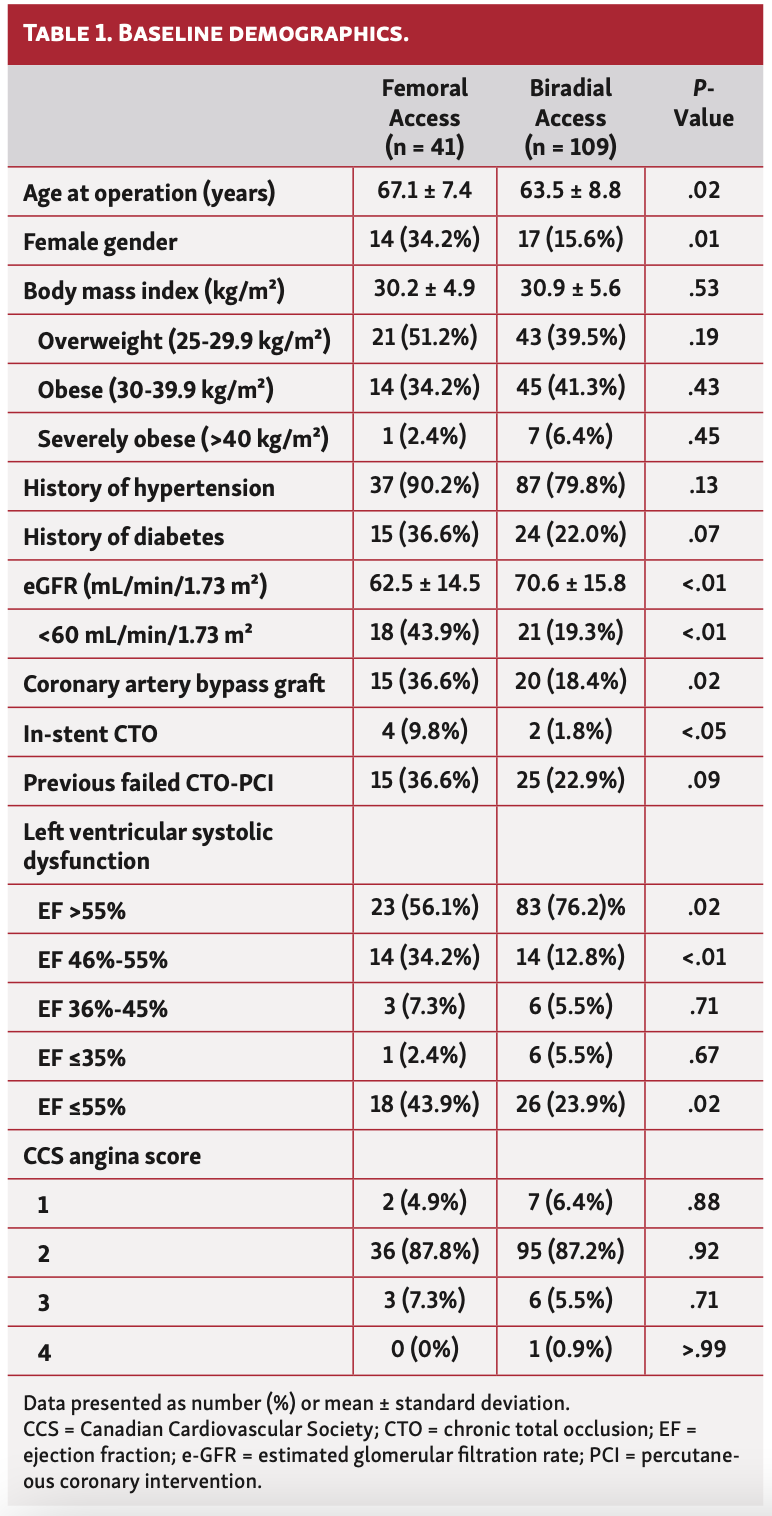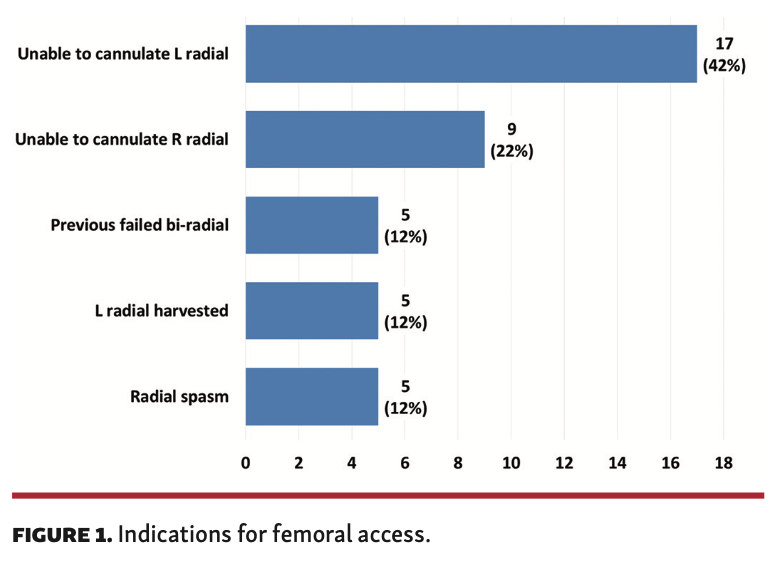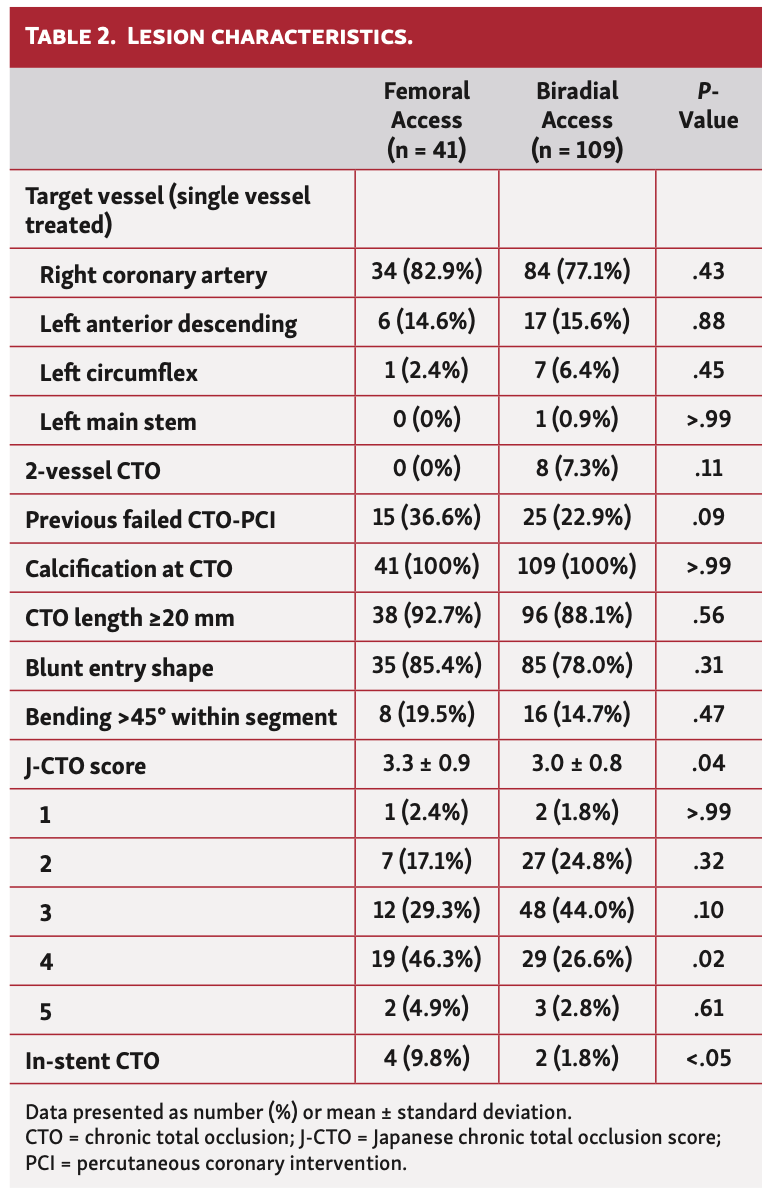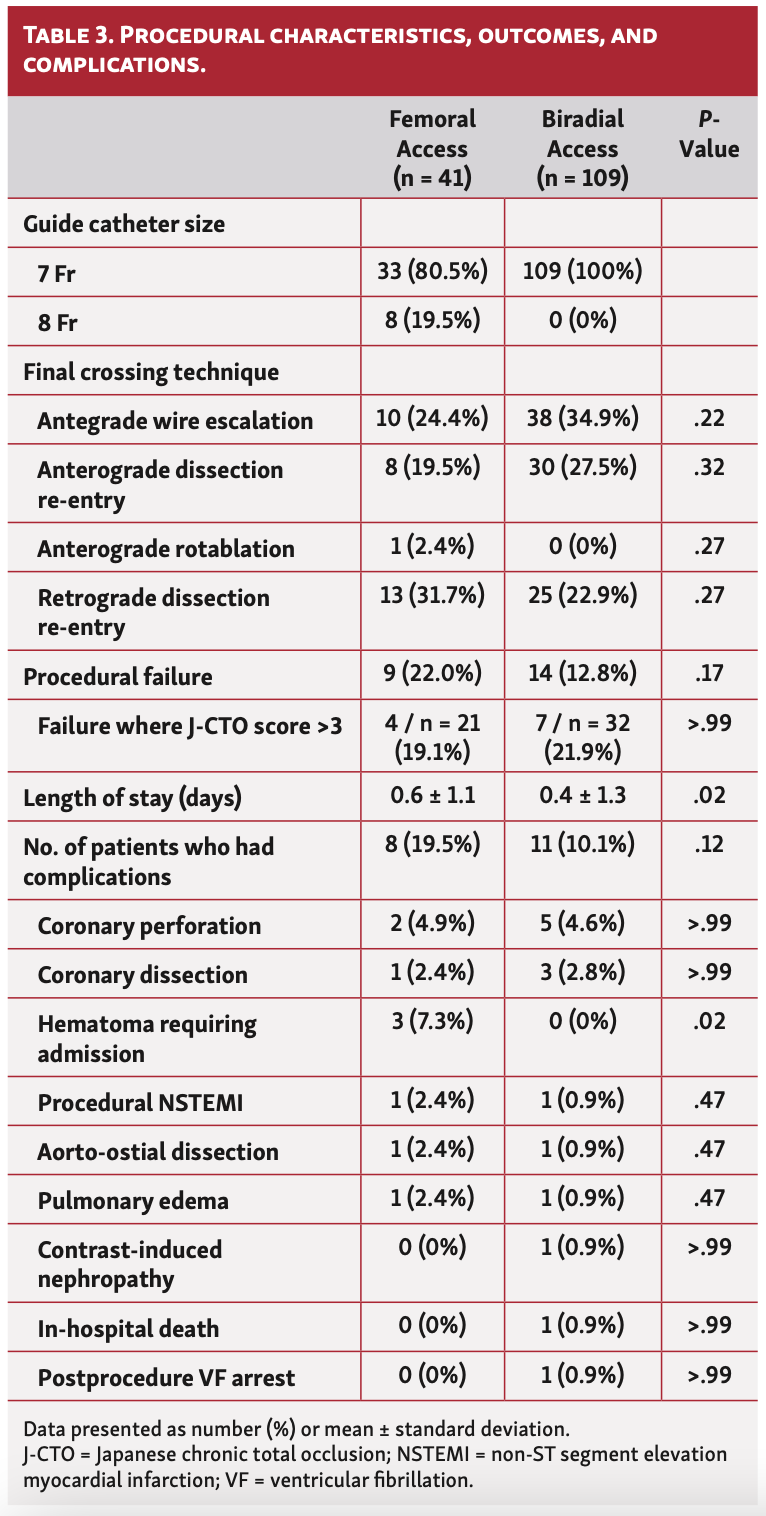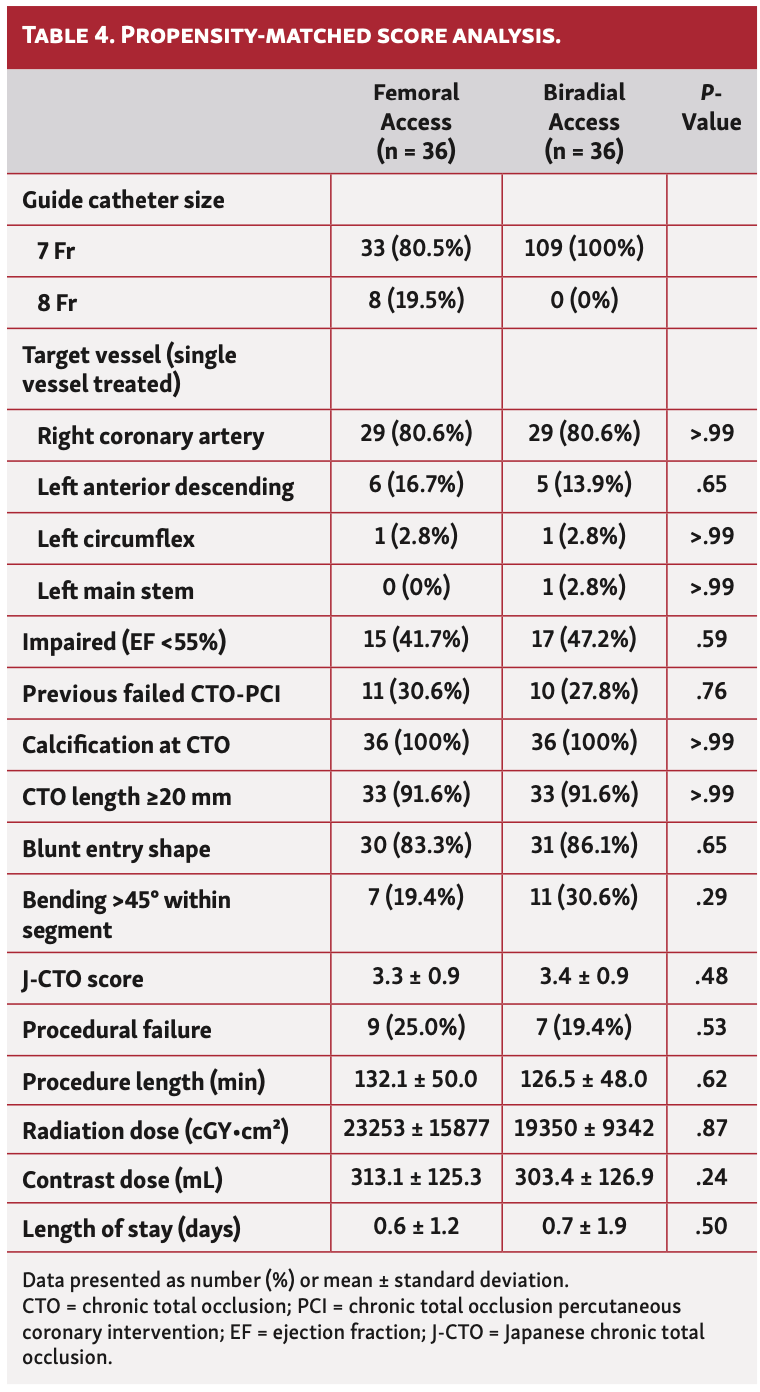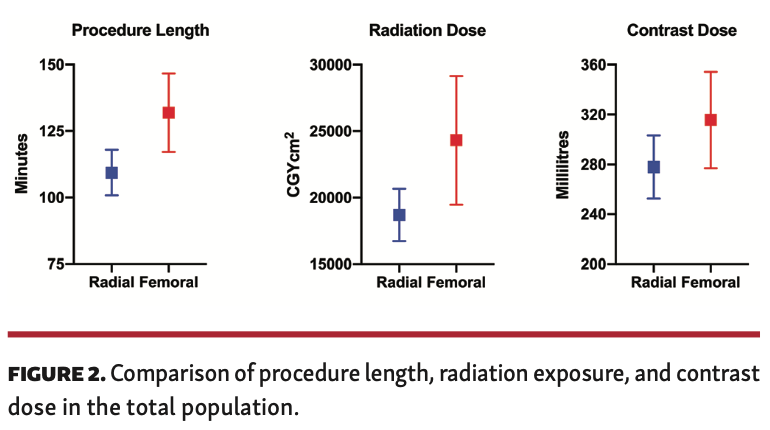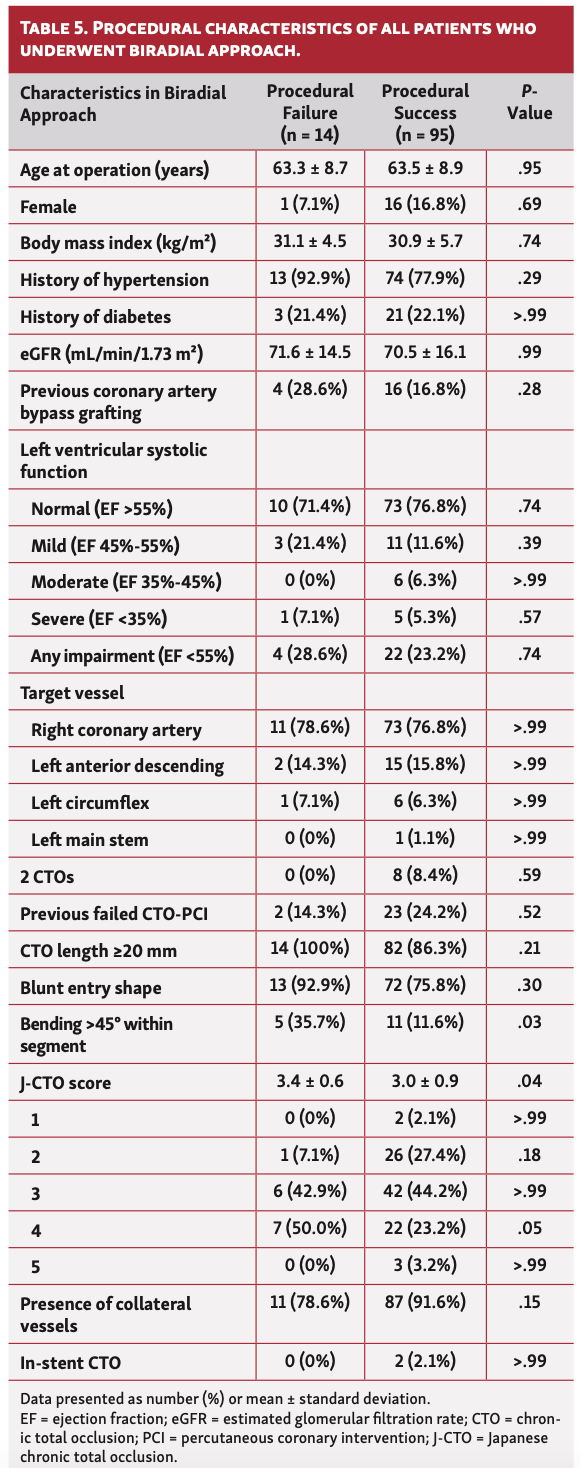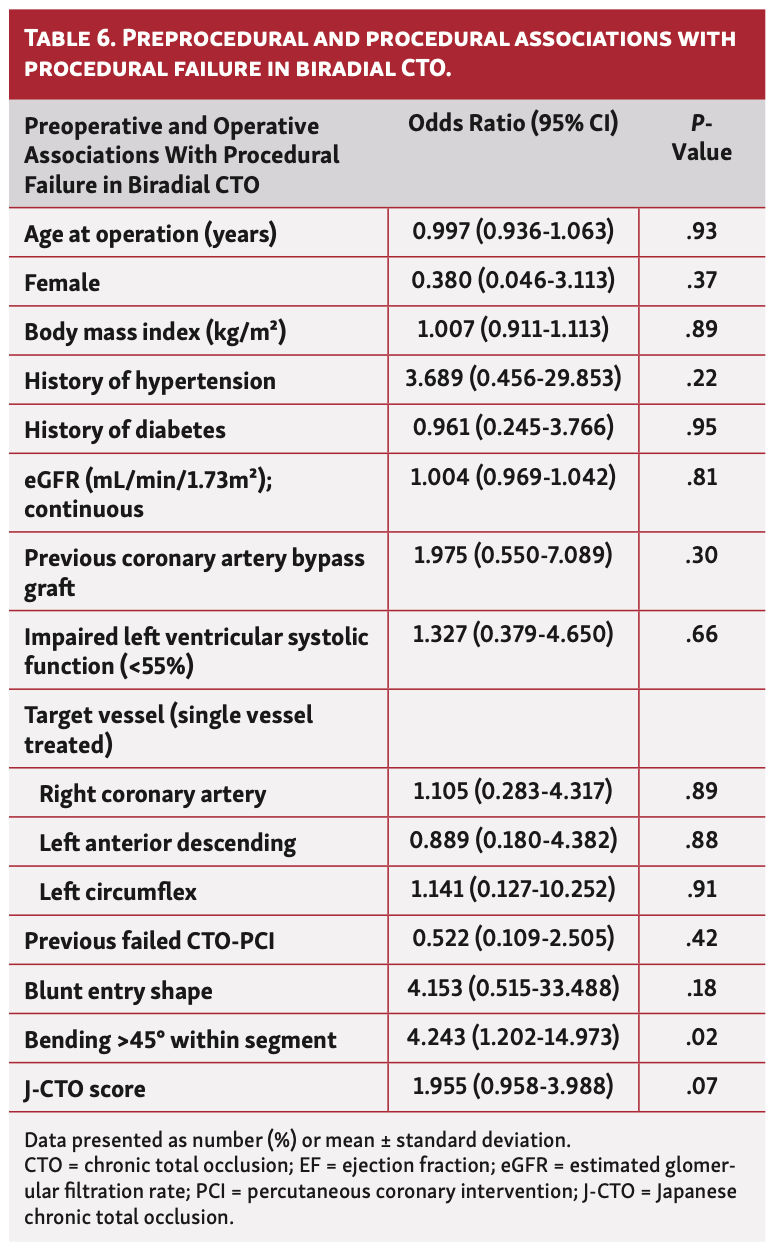ADVERTISEMENT
Complex Chronic Total Occlusion Revascularization — A Comparison of Biradial Versus Femoral Access
Abstract
Background. Complex chronic total occlusion (CTO) cases often require dual access. Evidence suggests that radial access is associated with lower success rates in complex CTOs. Our primary outcome was to determine efficacy of biradial access compared with femoral access. Methods. This was a retrospective, single-center, observational study. Patients who underwent dual-access CTO percutaneous coronary intervention (PCI) between January 2014 and January 2018 were enrolled. They were separated into biradial and femoral access groups. Data on demographics, comorbidities, complications, lesion characteristics, radiation, and contrast dose were collected. Standard univariate analyses were performed to identify predictors for revascularization failure. Results. There were 150 cases identified, 109 biradial and 41 femoral access. There was no significant difference in success rate between the radial and femoral groups (87% vs 78%, respectively; P=.17). The average J-CTO score was 3 vs 4 (P=.04). Matched cohort analysis showed equivalent success rates (80.6% vs 75.0%, respectively; P=.53). Elevated body mass index, poor renal function, previous coronary artery bypass grafting, higher J-CTO, CTO >20 mm, presence of >45° bend within the diseased segment, and absence of collaterals were associated with CTO-PCI failure. Biradial access had shorter procedures (111 minutes vs 147 minutes; P<.01), reduced radiation exposure (dose-area product, 17,452 cGy•cm2 vs 23,651 cGy•cm2; P<.01), less contrast (237 mL vs 315 mL; P=.11) and reduced hospital stay (0.38 ± 1.3 days vs 0.61 ± 1.1 days; P=.02). Conclusion. With shorter length of stay, fewer complications, and less radiation used in radial cases, we suggest biradial access is an effective and safe alternative in CTO-PCI. Prospective studies are needed to determine superiority.
J INVASIVE CARDIOL 2021;33(1):E52-E58. doi:10.25270/jic/20.00186
Key words: CTO access, CTO revascularization
Chronic total occlusions (CTOs) represent some of the most technically challenging lesions in percutaneous coronary intervention (PCI). Current registry data suggest three-quarters of all CTO procedures involve femoral access.1 The most recent European Society of Cardiology (ESC) guidelines on myocardial revascularization made a class I recommendation for radial access as the standard approach in coronary angiography and PCI.2 Early studies have demonstrated the feasibility of radial access in “simple” CTO-PCI.3,4 Complex CTO-PCI occasionally requires dual-site access, to allow both anterograde and retrograde approaches. A determining factor relates to the complexity of lesions. This can be assessed using the Japanese chronic total occlusion (J-CTO) score,5 which takes into consideration 5 independent predictors of success and stratifies cases into easy (J-CTO = 0), intermediate (J-CTO = 1), difficult (J-CTO = 2), or very difficult (J-CTO = 3-5). It has been validated in multiple populations to successfully predict the ability to cross lesions within 30 minutes and subsequently revascularize the vessel.6,7 Tanaka et al8 demonstrated that in complex CTO cases where J-CTO scores ≥3 were examined, the radial group had significantly lower success rates than the femoral group. An editorial published in 2017 highlighted that Tanaka et al may not have represented what can be achieved with the most up-to-date equipment.9 With better technology and improvement in crossing techniques, alongside the routine use of 7 Fr catheters at our tertiary center, we aim to investigate how effective a biradial approach is compared with one that requires any femoral access.
The primary outcome is to determine how effective biradial access is compared with radio-femoral and bifemoral access in complex CTO cases. Secondary outcomes relate to contrast and radiation dose, length of procedure and in-hospital stay, and predictors of failure to revascularize in the biradial cohort.
Methods
We performed a retrospective single-center study of consecutive patients who were referred for CTO-PCI between January 2014 and January 2018. Patients were identified using a prospective database. Cases that were successfully managed with single access (radial or femoral) or where only diagnostic catheters were used in the secondary access were excluded. Data on baseline demographics, comorbidities, complications, radiation, and contrast dose were collected from electronic records. Every angiogram was reviewed independently to calculate a J-CTO score. Patients were divided into 2 groups, biradial or femoral access (including radiofemoral or bifemoral). CTO was defined as a coronary obstruction with Thrombolysis in Myocardial Infarction (TIMI) flow 0 and an estimated occlusion duration of >3 months. Previous length of occlusion was measured from the point of CTO to that of collateral flow. Success was defined as the ability to cross the lesion and a minimum of TIMI 2 anterograde flow. Previous failure was defined as the inability of any previous operator to cross the lesion and return a minimum of TIMI 2 anterograde flow. Details on the technique used to achieve final crossing were also collected.
All procedures were performed by a single operator who specializes in complex CTO-PCI. Biradial access was used as a default for all procedures unless otherwise indicated. Indications for femoral access were collected as part of the analysis. Every biradial case utilized 2 guiding catheters, including at least one 7 Fr catheter. Every patient had a previous invasive coronary angiogram with a confirmed CTO lesion. Patients were all pretreated with aspirin and clopidogrel and given heparin periprocedurally to maintain a target activated clotting time of >250 seconds.
Statistical analysis. Categorical variables are presented as absolute number (percentage), and comparisons were made using Chi-squared tests or Fisher’s exact tests where appropriate. Continuous variables are presented as mean ± standard deviation, and comparisons were made using Student’s t-tests. In the matched cohort, categorical comparisons were made using McNemar’s tests and continuous comparisons using Sign tests.
To account for differences in case mix, we developed a propensity score for femoral access group membership.10 The propensity for femoral access group membership was determined regardless of outcome, using multivariable logistic regression analysis.11 A full, non-parsimonious model was developed that included gender, previous failed CTO, history of coronary artery bypass grafting, estimated glomerular filtration rate (eGFR), and in-stent CTO lesions. The goal was to balance patient characteristics. A propensity score was created for each record; we then used a macro12 to perform a greedy 1:1 propensity match, without replacement. All statistical analyses were performed using SAS for Windows, version 9.3 (SAS Institute). A P-value of <.05 was considered statistically significant.
Results
A total of 491 CTO cases were identified, of which 150 required dual-site guide access. One hundred nine cases were biradial, and 41 cases required at least 1 femoral access (radiofemoral n = 36, bifemoral n = 5). The baseline demographics of each group are summarized in Table 1.
The femoral access cohort was older (67.1 ± 7.4 years in the femoral group vs 63.5 ± 8.8 years in the radial group; P=.02), with significantly more women (34.2% femoral vs 15.6% radial; P=.01). The mean eGFR was lower in the femoral population (62.5 ± 14.5 mL/min/1.73 m2 in the femoral group vs 70.6 ± 15.8 mL/min/1.73 m2 in the radial group; P<.01) with a significantly higher proportion of stage 3 chronic kidney disease or worse. There was a higher prevalence of patients with previous coronary artery bypass graft surgery in the femoral group (36.6% femoral vs 18.4% radial; P=.02). There was a trend toward a higher prevalence of diabetes and hypertension in the femoral group that did not reach statistical significance. Although differences were noted overall in the number of patients with normal left ventricular function (56.1% femoral vs 76.2% radial), there was no difference in those with moderate (ejection fraction, 36%-45%) or severe (ejection fraction, ≤35%) impairment. Most patients were classified as obese, with a mean body mass index of 30.2 ± 4.9 kg/m2 in the femoral group and 30.9 ± 5.6 kg/m2 in the biradial group.
Figure 1 summarizes indications for femoral access chosen by our operator. The most common reason to proceed with femoral access was related to failure or inability to cannulate the radial artery. In 5 femoral cases (12%), the biradial approach had previously failed.
Lesion characteristics are summarized in Table 2. The mean J-CTO score in our total cohort was 3.12. The mean J-CTO score was 3.3 ± 0.9 in the femoral group vs 3.0 ± 0.8 in the radial group (P=.04), indicating that those undergoing femoral procedures had more complex lesions. Most CTO cases involved right coronary artery PCI. Failed attempt at PCI by another operator accounted for 26.6% of cases with a trend toward the use of femoral access in these cases (36.6% femoral vs 22.9% radial; P=.09). Every case where >1 CTO-PCI was required was done via radial access (0% femoral vs 7.3% radial; P=.11).
Table 3 summarizes procedural characteristics, outcomes and complications. Every case utilized at least one 7 Fr guiding catheter. An 8 Fr guiding catheter was used in 19.5% of femoral cases. No difference was noted in the use of anterograde or retrograde crossing techniques between the radial and femoral groups. There was a trend toward higher failure rates with femoral access, although this did not reach statistical significance (22% femoral vs 14% radial; P=.17). Failure rates were equivalent in both groups when comparing cases with a J-CTO score of >3 (19.9% femoral vs 21.9% radial; P≥.99).
Some patients had more than 1 complication; the breakdown of individual complications is detailed in Table 3. A trend toward a higher rate of complications was noted in the femoral group (19.5% femoral vs 10.1% radial; P=.12). This was driven primarily by a higher incidence of hematomas requiring overnight hospital admission.
Figure 2 highlights the differences seen in procedure length, radiation exposure, and contrast dose. The time taken to complete the procedure was less in the radial group (109.4 ± 44.8 minutes in radial vs 131.9 ± 46.9 minutes in femoral; P<.01) and required lower doses of radiation (dose area product, 18,694 ± 10,381 cGy•cm² in the radial group vs 24,314 ± 15,357 cGy•cm² in the femoral group; P<.01). Although less contrast was required (277.9 ± 133 mL in the radial group vs 315.7 ± 122.4 mL in the femoral group; P=.11), this did not reach statistical significance. Moreover, the radial group had a significantly shorter length of in-hospital stay (0.38 ± 1.3 days in the radial group vs 0.61 ± 1.1 days in the femoral group; P=.02).
Propensity-score matched results. Of the 41 femoral patients, we matched 36 to patients from the radial access group. Results are summarized in Table 4. In this sample, the cohorts had comparable J-CTO scores (3.3 ± 0.9 in the femoral group vs 3.4 ± 0.9 in the radial group; P=.48) and failure rates were equivalent across both groups (25.0% in the femoral group vs 19.4% in the radial group; P=.53). Interestingly, in the matched cohort, the differences in procedure length, radiation and contrast dose, and length of stay were no longer apparent.
Table 5 summarizes the characteristics of successful and failed cases with a biradial approach. Only the presence of a bend >45° within the lesion and a higher J-CTO score appeared to predict failure. We calculated odds ratios (Table 6).
Discussion
We present a more complex population of patients who have undergone CTO-PCI. These cases represent the most difficult CTO lesions seen at our tertiary center over a 4-year period. Only 24.7% of cases had a J-CTO score of <3, and none of the cases had a score of 0. We identified our study population by recruiting only those in whom both anterograde and retrograde access were deemed necessary. As a result, the mean J-CTO score is significantly higher than in any other published study (3.3 ± 0.9 in the femoral group vs 3.0 ± 0.8 in the biradial group). By comparison, in RECHARGE,1 an international multicenter registry, mean transfemoral J-CTO was 2.3 ± 1.1 and transradial J-CTO was 2.1 ± 1.2. In a study by Tanaka et al,8 mean transfemoral J-CTO was 1.9 ± 1.1 and mean transradial J-CTO was 1.3 ± 1.0.
Inability to achieve radial access, due to a failure to cannulate or the poor condition of the radial artery, was the most common reason to choose femoral access. However, there was a small number of cases within the femoral group (n = 5; 12%) where radial access had previously failed. When taken at face value, our findings suggest failure rates are equivalent with a trend toward superiority in the radial group, but this must be put into context as the femoral cohort was more comorbid and had a significantly higher J-CTO score. Nevertheless, when analyzing the most complex lesions (where J-CTO score was >3) or when propensity matching patients in both groups, no difference was observed in failure. Therefore, in most cases, at the hands of an experienced operator, choice of access did not influence the ability to achieve successful revascularization.
Tanaka et al found when those with scores of ≥3 were examined, the radial group had significantly lower success rates than the femoral group (35.7% vs 58.2%, respectively).8 They reported that the use of a guiding catheter <7 Fr, degree of calcification, occlusion length, and patient age were independently associated with CTO-PCI failure when attempted radially. Tanaka et al concluded that the transfemoral approach should be preferentially considered in complex CTO cases.8 Our practice is to start with a radial approach and only utilize a femoral one if this has previously failed or if radial access cannot be achieved. This practice is validated by the equivalent success rates and the comparative safety of the radial approach both in terms of complications and in contrast/radiation dose delivered. At our center, 7 Fr catheters are routinely used in CTO cases, which may partially explain why our success rates in complex cases are higher. Radial access appeared to fail more in our cohort in lesions with significant bends >45° as is the case in bifurcation lesions. In these uncommon circumstances (12% of femoral cases), femoral access was chosen to allow the use of 8 Fr catheters, which provide added support.
Although this represents a relatively large cohort of complex CTO cases (113/150 cases had a J-CTO score of ≥ 3; comparatively, the Tanaka et al cohort had 119/5858), the numbers were too small to accurately determine predictors of failure in the biradial group. Moreover, the majority of CTO cases involved the right coronary artery. This is not unusual; both Tanaka et al and the RECHARGE registry present cases that are predominantly right-sided lesions.1,8 Despite this, a higher J-CTO score and the presence of a bend >45° within the diseased segment did appear to contribute significantly to failure.
We have shown that radial access is a reasonable alternative to femoral access even in complex cases where anterograde and retrograde approaches may be necessary. A randomized controlled trial where lesions of equivalent complexity are managed radially or femorally would be the next definitive step.
Study limitations. This was a single-center, single-operator, non-randomized observational study, and as such selection bias is inherent. The sample size is relatively small, which limits both our ability to propensity match and the power of our statistical analysis. The femoral cohort is carefully selected after failure to achieve radial access or, to a lesser extent, previous failure to revascularize via a biradial approach. The majority of cases were right coronary artery CTOs, which may impact the generalizability of the results in non-right coronary artery lesions. A further limitation to the generalizability is operator experience. Our center ranks among the highest in terms of numbers of PCI procedures undertaken in the country. All complex CTOs are performed by a “super-operator,” thus, skill levels may not be comparable throughout the international community.
Conclusion
Biradial access appears to be a feasible alternative to femoral access in complex CTO-PCIs with shorter length of stay, fewer complications, and less radiation dose. In our cohort, lesions with a significant bend appeared to predict radial access failure. Prospective, randomized studies are required to accurately determine superiority.
From the Liverpool Heart and Chest Hospital, United Kingdom.
Disclosure: The authors have completed and returned the ICMJE Form for Disclosure of Potential Conflicts of Interest. The authors report no conflicts of interest regarding the content herein.
Final version accepted June 29, 2020.
Address for correspondence: Tobin Joseph, MBBS, BSc, Liverpool Heart and Chest Hospital, Liverpool, United Kingdom. Email: t.joseph@doctors.org.uk
- Bakker EK, Maeremans J, Zivelonghi C, et al. Fully transradial versus transfemoral approach for percutaneous intervention of coronary chronic total occlusions applying the hybrid algorithm insights from RECHARGE registry. Circ Cardiovasc Interv. 2017;10:e005255.
- Sousa-Uva M, Neumann FJ, Ahlsson A, et al. 2018 ESC/EACTS guidelines on myocardial revascularization. Eur J Cardiothorac Surg. 2019;55:4-90.
- Rathore S, Hakeem A, Pauriah M, Roberts E, Beaumont A, Morris JL. A comparison of the transradial and the transfemoral approach in chronic total occlusion percutaneous coronary intervention. Catheter Cardiovasc Interv. 2009;73:883-887.
- Yang CH, Guo GB, Chen SM, et al. Feasibility and safety of a transradial approach in intervention for chronic total occlusion of coronary arteries: a single-center experience. Chang Gung Med J. 2010;33:639-645.
- Morino Y, Abe M, Morimoto T, et al. Predicting successful guidewire crossing through chronic total occlusion of native coronary lesions within 30 minutes. JACC Cardiovasc Interv. 2011;4:213-221.
- Nombela-Franco L, Urena M, Jerez-Valero M, et al. Validation of the J-chronic total occlusion score for chronic total occlusion percutaneous coronary intervention in an independent contemporary cohort. Circ Cardiovasc Interv. 2013;6:635-643.
- Syrseloudis D, Secco GG, Barrero EA, et al. Increase in J-CTO lesion complexity score explains the disparity between recanalisation success and evolution of chronic total occlusion strategies: insights from a single-centre 10-year experience. Heart. 2013;99:474-479.
- Tanaka Y, Moriyama N, Ochiai T, et al. Transradial coronary interventions for complex chronic total occlusions. JACC Cardiovasc Interv. 2017;10:235-243.
- Rinfret S, Dautov R. Radial or remoral approach for chronic total occlusion revascularization? The answer is both. JACC Cardiovasc Interv. 2017;10:244-246.
- Sommer R. Comparing apples and oranges. J Consum Stud Home Econ. 1984;8:299-304.
- Hosmer D, Lemeshow S. Applied Logistic Regression. 2nd ed. John Wiley & Sons Inc; 1989. Accessed December 15, 2020. http://resource.heartonline.cn/20150528/1_3kOQSTg.pdf.
- Parsons LS. Performing a 1:N case-control match on propensity score. Paper presented at the 26th Annual SAS Users Group International Conference; April 21-25; Long Beach, CA.






